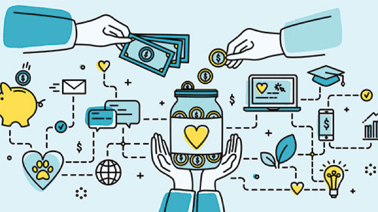 The COVID-19 pandemic and its economic downturn might have exposed how fragile your finances are. As the economy begins to recover, it’s a good time to consider building an emergency fund to help protect you in the future. Consider this information as you start to put money away:
The COVID-19 pandemic and its economic downturn might have exposed how fragile your finances are. As the economy begins to recover, it’s a good time to consider building an emergency fund to help protect you in the future. Consider this information as you start to put money away:
What is an emergency fund?
At the most basic level, Investopedia defines an emergency fund as, “money stashed away that people can use in times of financial distress.” You might have a savings account, but if you routinely dip into it to pay bills or splurge on a big-ticket item, it’s not a true emergency fund. The money in this fund is locked away for unexpected big expenses, like home repair following a disaster, illness, or the unexpected loss of a job. It also typically refers to assets you have easy access to, like in a financial institution, and solutions that don’t require you to acquire additional debt, such as credit cards or loans.
How much to save?
When you’re trying to calculate how much to save, there are a lot of opinions out there. That also means there’s not a good one-size-fits-all solution. Most experts agree your emergency fund should cover several months of lost pay, with most sources advising an average of three to six months of living expenses as a good goal to aim for. Since the pandemic, however, some advisors have bumped that up to eight months or a year of expenses, since that’s how long our economy was disrupted.
In the end, only you and a trusted advisor can determine what goal fits you best. If your job is in a seasonal industry or you’re a freelancer, Margarette Burnette of NerdWallet suggests aiming for a higher goal, since there could be periods of time where you aren’t paid or work dries up. Even if your job makes saving a large lump sum of cash seem like a pipe dream, she suggests starting out with an emergency fund of $500 is better than nothing, and can help cover minor issues.
Where to start?
The first big step on your emergency savings journey is just setting your goal amount. Knowing exactly how much you want to save will help you chart your progress and keep you motivated, according to the Consumer Financial Protection Bureau. From there, reaching your goal is easier if you set up a way to ensure you make regular contributions. This can be by adding money from your paycheck to a savings account on payday or charting your expenditures and putting the remaining money away. While you watch the account hit milestones, the CFPB notes it’s important to celebrate your success along the way.
With an emergency fund in place, it’s easier for you to whether financial difficulties if they hit your family. It’ll also give you peace of mind when you think about what the future might hold.